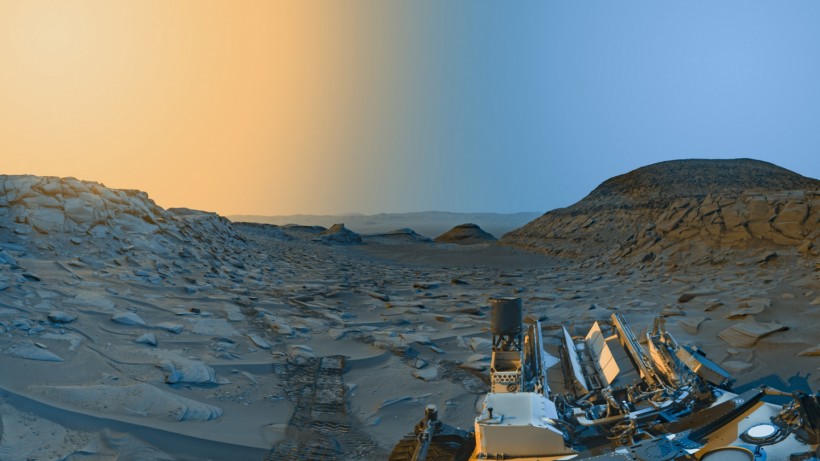NASA's Curiosity Mars rover has captured a breathtaking view of the Martian landscape, showcasing what morning looks like on the Red Planet.
After completing a significant software update in April, the rover bid farewell to "Marker Band Valley" but not before capturing a stunning "postcard" of the scene.

Martian Postcard
The postcard is an artistic rendition of the landscape, combining color-enhanced versions of two black-and-white panoramas taken by Curiosity's navigation cameras.
These views were captured at different times of the day, precisely at 9:20 a.m. and 3:40 p.m. local Mars time on April 8. By merging the images taken in contrasting lighting conditions, the details of the terrain come to life.
The morning shots were accentuated with blue hues, while the afternoon shots were enhanced with yellow tones. This technique was employed previously by Curiosity in November 2021, producing similarly captivating results.
The byproduct is nothing short of awe-inspiring. Curiosity finds itself in the foothills of Mount Sharp, an imposing 3-mile-high (5 kilometers) mountain within Gale Crater. The rover has been diligently exploring this region since its momentous landing in 2012.
Stretching into the distance, Marker Band Valley emerges beyond the tracks left by Curiosity. This meandering expanse finds its place within the "sulfate-bearing region" and unveils surprising remnants of an ancient lake as the rover diligently conducted its investigations.
Continuing downward, at the center and to the right of the image, two prominent hills bearing the names "Bolívar" and "Deepdale" grace the scene. Curiosity charted its course between these hills while navigating through the "Paraitepuy Pass."
Read Also: From Mars to Earth: Meet NASA's Spherical Robots Saving Lives in Disasters
Stage Lighting on Mars
Curiosity engineer Doug Ellison, based at NASA's Jet Propulsion Laboratory in Southern California, emphasized the visual differences that occur between morning and afternoon. "Anyone who's been to a national park knows the scene looks different in the morning than it does in the afternoon," he explained.
The strategic capture of images at two different times of day created contrasting shadows, akin to stage lighting. The Sun served as Curiosity's sole source of illumination, resulting in dramatic shadow effects.
Furthermore, the winter season, characterized by reduced airborne dust, added depth to the shadows in the image. Ellison clarified, "Mars' shadows get sharper and deeper when there's low dust and softer when there's lots of dust."
This unique combination of lighting conditions and minimal dust allowed for the creation of a truly captivating visual composition.
Offering a glimpse into the rover's backside, the image reveals the presence of three antennas and a nuclear power source. Particularly noteworthy is the Radiation Assessment Detector (RAD) instrument, depicted as a white circle in the lower right segment of the image.
This crucial tool has played a pivotal role in advancing scientists' comprehension of safeguarding prospective astronauts against radiation during their Martian ventures.
Curiosity's latest postcard from Mars serves as a testament to the incredible scientific achievements and artistic beauty that continue to unfold on the Red Planet.
As the rover embarks on new exploratory endeavors, its remarkable discoveries and captivating imagery inspire awe and ignite curiosity about the mysteries of our neighboring planet.
Related Article: Mars' Crust Made of 'Heavy Armor' Says New Study, Will this Tough Exterior be a Problem Soon?






